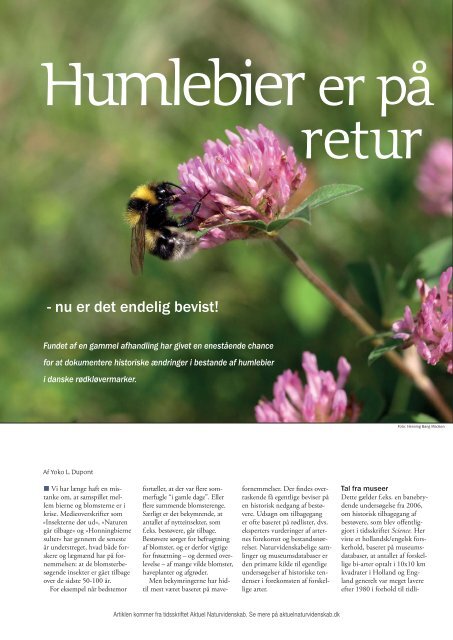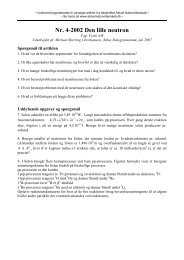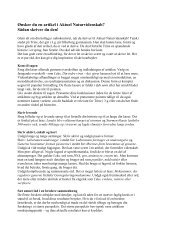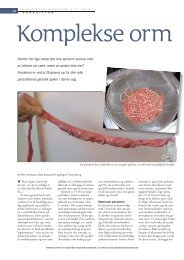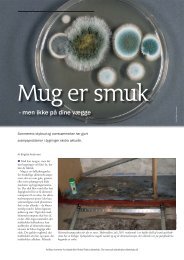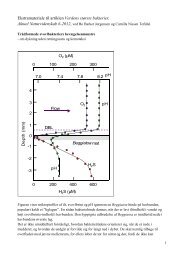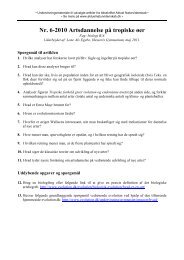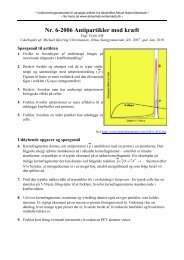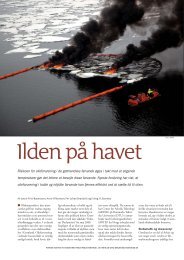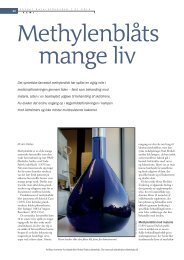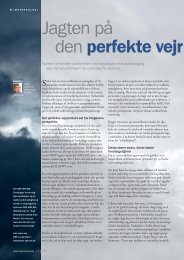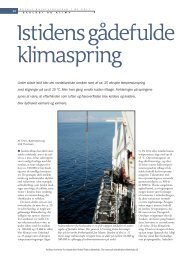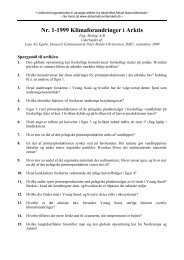- nu er det endelig bevist! - Aktuel Naturvidenskab
- nu er det endelig bevist! - Aktuel Naturvidenskab
- nu er det endelig bevist! - Aktuel Naturvidenskab
You also want an ePaper? Increase the reach of your titles
YUMPU automatically turns print PDFs into web optimized ePapers that Google loves.
8A k t u e l N a t u r v i d e n s k a b | 2 | 2 0 1 2Ø K O L O G ILandskabet set med humlebi-øjneForsk<strong>er</strong>ne <strong>er</strong> gen<strong>er</strong>elt enigeom, at <strong>det</strong> <strong>er</strong> landbrugsintensiv<strong>er</strong>ingenog landskabsændring<strong>er</strong>siden landbrugetsindustrialis<strong>er</strong>ing i 1950’<strong>er</strong>ne,som <strong>er</strong> hovedansvarlig for tilbagegangenaf humlebi<strong>er</strong>. Menhvilke landskabselement<strong>er</strong> <strong>er</strong>vigtige set fra humlebi<strong>er</strong>nesp<strong>er</strong>spektiv? I et biologispecialefra 2009 und<strong>er</strong>søgte DennisBoll betydningen af oplan<strong>det</strong>ssammensætning for tæthedenaf humlebi<strong>er</strong> (bi<strong>er</strong>/kvadratmet<strong>er</strong>)på en rødkløv<strong>er</strong>mark. For i alt17 rødkløv<strong>er</strong>mark<strong>er</strong> i Jylland ogpå Fyn inddelte han mark<strong>er</strong>nesomgivels<strong>er</strong> i forskellige typ<strong>er</strong>,f.eks. kornmark<strong>er</strong>, blomtrendeafgrød<strong>er</strong>, skov, f<strong>er</strong>skvand, hegnmv. For de forskellige art<strong>er</strong> afhumlebi<strong>er</strong> var d<strong>er</strong> lidt forskelpå hvilke landskabstyp<strong>er</strong>, somhavde den største påvirkningpå antallet af bi<strong>er</strong>. Gen<strong>er</strong>elt vartilstedeværelsen af blomst<strong>er</strong>rigeareal<strong>er</strong>, som enge og hav<strong>er</strong>, envigtig positiv faktor. Men ogsåskov spillede en rolle for nogleart<strong>er</strong>. Skove kan have betydningFarvekode Areal kategoriRødkløv<strong>er</strong>Vindbestøvede afgrød<strong>er</strong>Insektbestøvede afgrød<strong>er</strong>Skov (løv og nål)Eng (blomst<strong>er</strong>-rig)KratLevende hegnGræsdomin<strong>er</strong>ede omr. (blomst<strong>er</strong>-fattig)F<strong>er</strong>skvand (sø og vandløb)Vej og grøftekant<strong>er</strong>Bebyggelse og hav<strong>er</strong>som fødesøgningssted, redested,ell<strong>er</strong> som ov<strong>er</strong>vintringssted.Cirkl<strong>er</strong>ne vis<strong>er</strong> omgivels<strong>er</strong>af to rødkløv<strong>er</strong>mark<strong>er</strong> indenforen radius af 500 met<strong>er</strong>, som <strong>er</strong>fødesøgningsafstanden for langtde fl este humlebiart<strong>er</strong>. Cirklentil højre vis<strong>er</strong> et landskabsmæssigtmeget broget område medmange større og mindre areal<strong>er</strong>med blomst<strong>er</strong>, samt mulig<strong>er</strong>edested<strong>er</strong> til humlebi<strong>er</strong>. Cirklentil venstre vis<strong>er</strong> et område, som<strong>er</strong> domin<strong>er</strong>et af kornmark<strong>er</strong>, somikke <strong>er</strong> egnede som fødesøgnings-og redested<strong>er</strong>. D<strong>er</strong> vistesig at være en langt høj<strong>er</strong>e tæthedaf humlebi<strong>er</strong> og fl <strong>er</strong>e art<strong>er</strong> iområ<strong>det</strong> til højre.forekomst (tilstedeværelse ell<strong>er</strong>ikke) historisk og geografisk.Men <strong>det</strong> <strong>er</strong> mindre godt til atvurd<strong>er</strong>e historiske ændring<strong>er</strong> ibestandsstørrels<strong>er</strong>, dvs. antalbi<strong>er</strong> pr. kvadratmet<strong>er</strong> (såkaldtetæthed<strong>er</strong>).Heldigt fund fra 1936Præcis hvilke art<strong>er</strong>, og hvormeget de enkelte art<strong>er</strong> <strong>er</strong> gåettilbage i antal ov<strong>er</strong> en årrække,var d<strong>er</strong>imod stort set ukendtindtil for nyligt. For et par årsiden faldt jeg og mine kollega<strong>er</strong>på Aarhus Univ<strong>er</strong>sitet(Christian Damgaard og VibekeSimonsen) dog ov<strong>er</strong> en gammelafhandling fra 1936 om bestøvningaf rødkløv<strong>er</strong>.Rødkløv<strong>er</strong> blev før industrialis<strong>er</strong>ingeni 1950’<strong>er</strong>ne brugt tiljordforbedring samt som kvægfod<strong>er</strong>,og var meget udbredtsom afgrøde i Nordeuropa.Rødkløv<strong>er</strong> har blomst<strong>er</strong>hoved<strong>er</strong>,som består af et stort antallange, smalle blomst<strong>er</strong>, somkun langtungede insekt<strong>er</strong> – ipraksis humlebi<strong>er</strong> – kan sugenektar fra, og d<strong>er</strong>med bestøve.I modsætning til de vildtlevendehumlebi<strong>er</strong>, har honningbi<strong>er</strong>,som udsættes i stad<strong>er</strong>,kort<strong>er</strong>e tung<strong>er</strong>, og <strong>er</strong> d<strong>er</strong>forikke helt så effektive som bestøv<strong>er</strong>e.Rødkløv<strong>er</strong> <strong>er</strong> afhængig afbestøvning for at sætte frø. Idatidens Danmark var d<strong>er</strong> d<strong>er</strong>forstor int<strong>er</strong>esse for bestøvningenaf rødkløv<strong>er</strong> i produktionsøjemed(frøproduktion).I februar 1930 blev d<strong>er</strong> d<strong>er</strong>forudskrevet en prisopgave om»Humlebi<strong>er</strong>nes betydning forrødkløv<strong>er</strong>ens bestøvning, ogde forskellige humlebiart<strong>er</strong>soptræden og boplads<strong>er</strong> indenfor typiske områd<strong>er</strong> i danskelandskab<strong>er</strong>«.Historiske und<strong>er</strong>søgels<strong>er</strong>gentagesPrisvind<strong>er</strong>en O.S. Skovgaardfortsatte i de følgende år sine<strong>det</strong>alj<strong>er</strong>ede und<strong>er</strong>søgels<strong>er</strong> afhumlebi<strong>er</strong> i rødkløv<strong>er</strong>mark<strong>er</strong>.Da indsamlingsmetod<strong>er</strong> ogresultat<strong>er</strong> var meget <strong>det</strong>alj<strong>er</strong>etbeskrevet i hans afhandling, harvi været i stand til at gentageund<strong>er</strong>søgelsen i dag på stort setde samme lokalitet<strong>er</strong>.Sammenligningen af de historiskedata og <strong>nu</strong>tidige obs<strong>er</strong>vation<strong>er</strong>har givet os en eneståendemulighed for direkte at måleden historiske tilbagegang, ikkekun i artstal, men også i tæthedaf humlebi<strong>er</strong> (dvs. antal p<strong>er</strong> kvadratmet<strong>er</strong>)i danske rødkløv<strong>er</strong>mark<strong>er</strong>.Langtungede art<strong>er</strong> <strong>er</strong>i tilbagegangDet viste sig, at fl<strong>er</strong>e art<strong>er</strong> varhelt forsvun<strong>det</strong> fra rødkløv<strong>er</strong>mark<strong>er</strong>ne,men også at <strong>det</strong>særligt <strong>er</strong> nogle humlebiart<strong>er</strong>,som <strong>er</strong> gået stærkt tilbage,mens andre klar<strong>er</strong> sig ganskegodt i et mod<strong>er</strong>ne opdyrketlandskab. Det <strong>er</strong> især de humlebiart<strong>er</strong>,som har forholdsvisArtiklen komm<strong>er</strong> fra tidsskriftet <strong>Aktuel</strong> <strong>Naturvidenskab</strong>. Se m<strong>er</strong>e på aktuelnaturvidenskab.dk
A k t u e l N a t u r v i d e n s k a b | 2 | 2 0 1 2Ø K O L O G I9Om forfatt<strong>er</strong>enYoko L. Dupont <strong>er</strong> lektor vedBioscience, Aarhus Univ<strong>er</strong>sitetE-mail:yoko.dupont@biology.au.dkEn korttunget humlebi (mørk Jordhumle, Bombus t<strong>er</strong>restris) besøg<strong>er</strong> rødkløv<strong>er</strong>blomst<strong>er</strong>.lange tung<strong>er</strong>, og som d<strong>er</strong>for <strong>er</strong>de bedste bestøv<strong>er</strong>e af rødkløv<strong>er</strong>,som <strong>er</strong> blevet sjældne i dag.De korttungede art<strong>er</strong>s bestande<strong>er</strong> d<strong>er</strong>imod næsten upåvirkedehistorisk.Da humlebi<strong>er</strong>, ud ov<strong>er</strong> atvære iøjnefaldende, karismatiskeinsekt<strong>er</strong>, også <strong>er</strong> en af devigtigste naturlige bestøv<strong>er</strong>e afbåde afgrød<strong>er</strong> og vilde plant<strong>er</strong>i Nordeuropa, kan dissebestandsændring<strong>er</strong> også fåbetydning for frøsætningenhos vores vilde flora og i landbrugsproduktion.Vi har således vist, at d<strong>er</strong> faktiskER sket den formode<strong>det</strong>ilbagegang i både artstal ogantal, i hv<strong>er</strong>t fald for de langtungedehumlebiart<strong>er</strong>, menikke for korttungede art<strong>er</strong>.Hvorfor nogle art<strong>er</strong> klar<strong>er</strong> sigdårligt, mens andre klar<strong>er</strong> siggodt i <strong>det</strong> mod<strong>er</strong>ne landskab,<strong>er</strong> et spørgsmål, som har storint<strong>er</strong>esse.Specialis<strong>er</strong>ing ell<strong>er</strong>vint<strong>er</strong>hiEr d<strong>er</strong> f.eks. særlige karakt<strong>er</strong>trækaf art<strong>er</strong>, som <strong>er</strong> særligtsårbare hhv. robuste? E<strong>nu</strong>dbredt hypotese <strong>er</strong>, at specialis<strong>er</strong>ingi forhold til fødevalggør en art sårbar, da “kræsne”art<strong>er</strong> kan miste d<strong>er</strong>es fødegrundlag,hvis d<strong>er</strong>es yndlingsblomst<strong>er</strong>forsvind<strong>er</strong>. Art<strong>er</strong>,som har et bredt fødevalg, vild<strong>er</strong>imod kunne udnytte tilbageværendeblomst<strong>er</strong>. Ulempenved at være specialis<strong>er</strong>et gæld<strong>er</strong>sandsynligvis også andre økologiskeaspekt<strong>er</strong>, f.eks. specifikkekrav til redested<strong>er</strong> ell<strong>er</strong>ov<strong>er</strong>vintringssted<strong>er</strong>.En anden hypotese går på,at humlebiart<strong>er</strong>, hvis dronning<strong>er</strong>komm<strong>er</strong> sent frem fra vint<strong>er</strong>hi,<strong>er</strong> hårdest ramt af tilbagegang.Sene humlebiart<strong>er</strong> <strong>er</strong>afhængige af tilstedeværelsenaf somm<strong>er</strong>blomst<strong>er</strong> – en ressource,som <strong>er</strong> blevet sjældn<strong>er</strong>ei ag<strong>er</strong>lan<strong>det</strong>. Endelig kend<strong>er</strong>vi meget lidt til forskelle mellemhumlebiart<strong>er</strong>s følsomhedov<strong>er</strong>for sprøjtegifte ell<strong>er</strong> sygdomme(som kan blive førtmed domestic<strong>er</strong>ede bi<strong>er</strong>), ell<strong>er</strong>tol<strong>er</strong>ance ov<strong>er</strong>for klimaændring<strong>er</strong>.Foto: Yoko L. Dupont.•Yd<strong>er</strong>lig<strong>er</strong>e læsningBiesmeij<strong>er</strong>, J.C. et al (2006):Parallel declines in pollinatorsand insect-pollinated plants inBritain and the Neth<strong>er</strong>lands.Science, 313, 351-354.Dupont, Y.L., Damgaard, C.& Simonsen, V. (2011) Quantitativehistorical change inbumblebee (Bombus spp.)assemblages of red clov<strong>er</strong> fields.PLoS One, in press. Kandownloades gratis på: http://dx.plos.org/10.1371/journal.pone.0025172.Dupont, Y.L. & Madsen, H.B.(2010) Humlebi<strong>er</strong>. Natur ogMuseum, 1, 1-36.Hagen, M., Wikelski, M. &Kissling, W.D. (2011) Spaceuse of bumblebees (Bombusspp.) revealed by radio-tracking.PLoS One, 6, e19997.Kan downloades gratis på:www.plosone.orgSkovgaard, O.S. (1936) Rødkløv<strong>er</strong>ensbestøvning, humlebi<strong>er</strong>og humlebo<strong>er</strong>. Det KongeligeDanske Videnskab<strong>er</strong>nesSelskabs Skrift<strong>er</strong> <strong>Naturvidenskab</strong>eligog Matematisk AfdelingRække 9, 6, 1-140.Artiklen komm<strong>er</strong> fra tidsskriftet <strong>Aktuel</strong> <strong>Naturvidenskab</strong>. Se m<strong>er</strong>e på aktuelnaturvidenskab.dk


